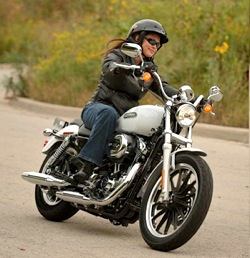|
Home ->
Guest Articles->
Motorcycle Riding
What You Should Know About Motorcycle Riding
What You Should Know About Motorcycle Riding
 While riding motorcycles has a bit of romance and adventure to it, there is a serious side to riding that can get overlooked sometimes. I know when I made the decision to start riding, I purposely didn't think about any of the safety issues, even when well meaning friends and family questioned me about it. I felt that I could ride safely and that I could handle whatever came my way. There are some points you should take into consideration when you decide to begin riding a motorcycle.
While riding motorcycles has a bit of romance and adventure to it, there is a serious side to riding that can get overlooked sometimes. I know when I made the decision to start riding, I purposely didn't think about any of the safety issues, even when well meaning friends and family questioned me about it. I felt that I could ride safely and that I could handle whatever came my way. There are some points you should take into consideration when you decide to begin riding a motorcycle.
- Over half of all fatal motorcycle accidents involve another vehicle. Most of the time, the motorist, not the motorcycle, is at fault. This puts you on the defensive as a motorcycle rider. Driving defensively could save your life, as well as the lives of those in the cars around you.
- Motorcycles can easily fit into a driver's blind spot. Car drivers need to learn to check for motorcycles, and motorcycle riders need to understand that even when they think they're visible, many car drivers can't see them. Many car drivers just don't think about motorcycles being on the road.
- It's difficult for a motorist to judge the size and speed of a motorcycle, because they are not used to seeing them. Often, motorists misjudge how close a motorcycle is or how fast it is approaching. As a motorcyclist, it is your job to keep yourself safely away from the cars on the road.
- When you're riding a motorcycle, you tend to slow down by releasing the throttle, not using the brake. It can be difficult for a motorist to detect your speed change. It is a good idea for a motorcyclist to get in the habit of using the brake, even if it is just to tap it, so the brake light goes on and the motorist knows what you're doing.
- Motorcyclists always need a way out - preferably two! It can be easy to get boxed in when you're riding a motorcycle in traffic. If you're not paying attention to your exit strategies, you might get stuck in a position where you have no outs, no control. A motorcycle provides excellent maneuverability, but it's not going to do you any good if you can't go anywhere! Always have an exit strategy while you're riding.
- Use your turn signals properly. Since the turn signals on the bike don't automatically turn themselves off, you've got to get in the habit of turning them off yourself. If you don't, the motorists behind you have no idea what you're about to do, creating an unsafe position for you to be in. Try to train your thumb to turn the signal on and then wait there. Turning off the signal is a step that is equally important.
- Stopping distance. Be sure to allow yourself ample stopping distance, no matter how quick you think your reactions are. Try to gauge the car behind you as well, and see if he's left ample stopping distance. If he's too close, signal him to back up. Also, be aware of stopping distances when you've got a passenger. The heavier the bike is, the more time it will take to stop it.
Safety is an enormous concern when riding a motorcycle. As much as we'd like to think that because we have a quick, maneuverable vehicle on the road, we're safe. That's just not the case. We always have to be alert and aware.
|
Her Motorcycle
Our Newsletter
|

 While riding motorcycles has a bit of romance and adventure to it, there is a serious side to riding that can get overlooked sometimes. I know when I made the decision to start riding, I purposely didn't think about any of the safety issues, even when well meaning friends and family questioned me about it. I felt that I could ride safely and that I could handle whatever came my way. There are some points you should take into consideration when you decide to begin riding a motorcycle.
While riding motorcycles has a bit of romance and adventure to it, there is a serious side to riding that can get overlooked sometimes. I know when I made the decision to start riding, I purposely didn't think about any of the safety issues, even when well meaning friends and family questioned me about it. I felt that I could ride safely and that I could handle whatever came my way. There are some points you should take into consideration when you decide to begin riding a motorcycle.





